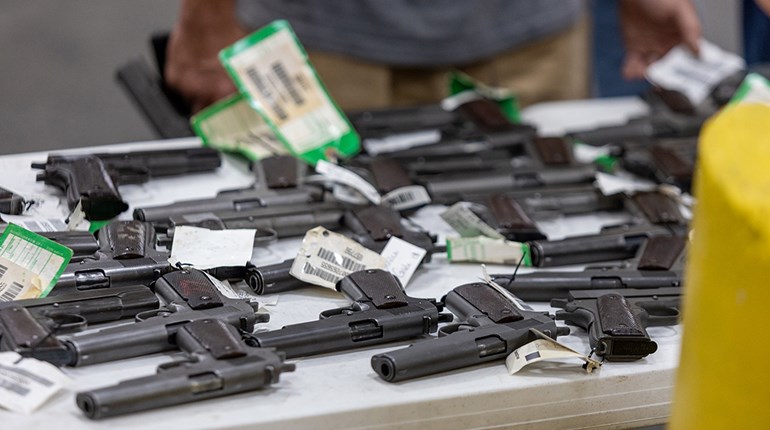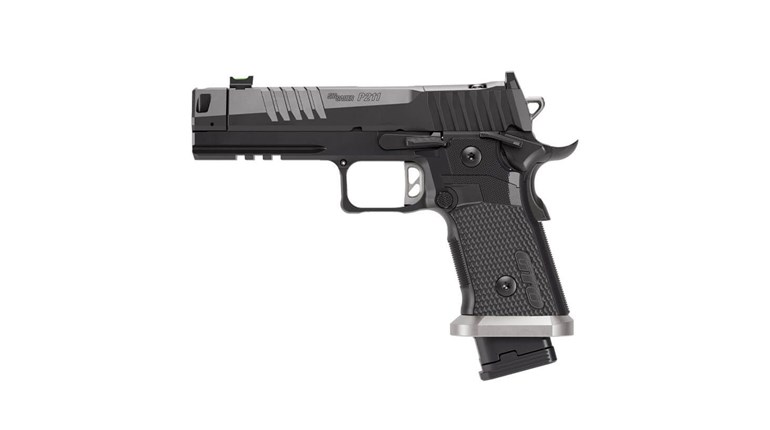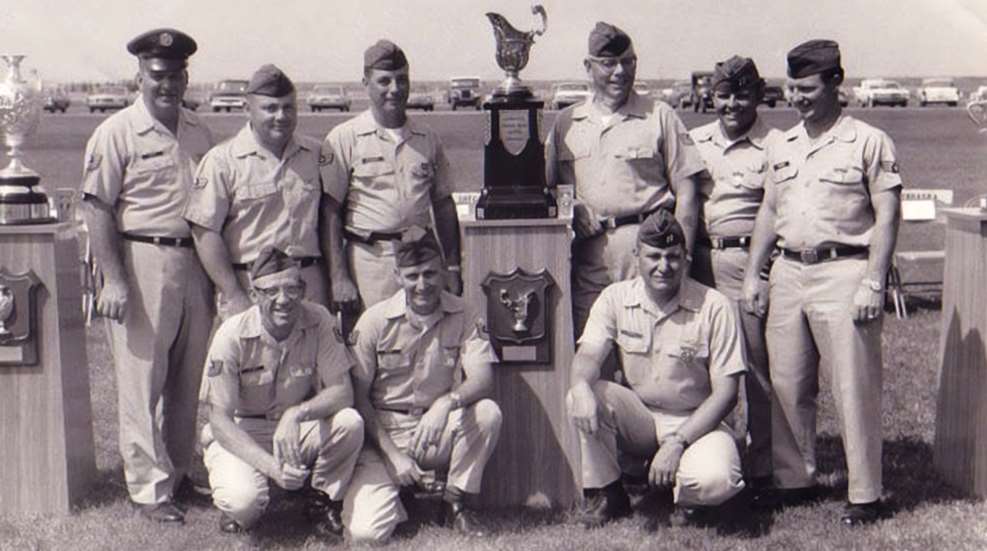
A member of the Air Force Pistol Marksmanship Team in the late 1980s and early 1990s, Dr. Robert “Doc” Engelmeier of Pittsburgh, Pa., documented his excursions, including at the National Matches. Read an excerpt from Dr. Engelmeier’s memoire below. (Article via CMP.)
A Hardball Odyssey
By Dr. Robert “Doc” Engelmeier
The purpose of this short commentary is to record what was perhaps the most memorable chapter of my Air Force career. I was fortunate to have received my advanced prosthodontic training at Wilford Hall USAF Medical Center in San Antonio, Texas, which arguably was and still is the strongest prosthodontic program in the country. That residency was followed by an Air Force-sponsored fellowship in maxillofacial prosthetics at MD Anderson Cancer Center in Houston—the largest cancer treatment center in the world. I was the last Air Force-sponsored person to train there before the Air Force launched its own maxillofacial program.
For the remainder of my Air Force career, fortune favored me with duty assignments where I could use my training to rehabilitate maxillofacial prosthodontic and prosthetic patients. However, beyond my professional career—which has absolutely defined me—the Air Force also afforded me a unique opportunity, unrelated to dentistry, that provided me with some of my best military friends and memories.
That opportunity was my nine-year tenure as a member of the U.S. Air Force National Pistol Team.
BEGINNINGS
In the summer of 1987, after returning from an appointment at David Grant USAF Hospital, my wife presented me with a somewhat worn “waiting room” copy of Airman magazine, which featured an article announcing the resurrection of an Air Force shooting program to replace the former legendary teams terminated more than a decade earlier due to severe defunding.
The new program would be meagerly funded as an MWR (Morale, Welfare and Recreation) activity, comparable to other minimally funded Air Force sports programs. Competitors were expected to provide their own firearms and ammunition and to train during their personal off-duty time. Some limited funds were available for team members to travel to important events as the National, Interservice and Olympic matches. The article also announced a search for interested service members to apply for an invitation to the upcoming selection camp where the coming year’s team would be chosen.
Though I had competed intermittently at local clubs throughout most of my adult life, I never believed that I was up to the task of competing at a national level. However, after reading the article and considerable urging by my wife, I called the MWR office at Randolph Air Force Base the next day. I managed to wrangle an invitation to the upcoming tryouts, but I humbly admit that their gracious invitation was certainly based on my rank of Colonel, rather than any personal shooting accomplishments.
At the time, all team members and tryout competitors were enlisted personnel serving as instructors. That year’s weeklong camp was conducted at Lackland Air Force Base in San Antonio, Texas. The intention of the camp was to identify a 10-person team for the coming year (a five-member primary team and a five-member developmental team). Of the 20-odd contenders who reported to the camp, nearly half had been on the previous year’s team and had recently returned from Camp Perry.
Needless to say, my only goal was to not embarrass myself.
Much to my surprise, after completing the selection process, I qualified. I finished in sixth place—the top scorer on the second-string team.
That 1987 training camp was conducted by the team’s coach, Ralph Talbot, a retired member of the U.S. Army National Shooting Team and holder of several national records. After observing my ability at the National Match Course, firing my personal hardball gun, the coach asked me to complete it again using his ball gun. My groupings immediately improved. Apparently, my gun had “shot loose” over the years.
As a result, he authorized me to be issued an AFPG ball gun for the 1988 season, while the Lackland Air Force Base gunsmith shop rebuilt my personal ball gun to a level of precision suitable for national competition. I had acquired my gun from Paul Mazerov, a lifelong friend who had taught me how to shoot.
A decorated Korean War combat Marine, Paul was a retired Colonel and one of the prime movers in my life. That National Match gun was originally built for him by USMC gunsmiths at Quantico two decades earlier. It was stamped with his service number, and is still one of my most prized possessions.
I competed with Paul’s team in the Pittsburgh Metropolitan Police Revolver League during my final two years of Dental School. In 1987, I located what would become my “Magic Ball Gun” at a pawn shop in Reno, Nev. It was comprised of an excellent Colt M-1911A1 receiver and a mint Union Switch and Signal slide. After removing that rare slide, I gave the pistol to the Gunsmith Shop at Lackland AFB to build me a premium-grade gun.
Master Gunsmith Bill Moore replaced all the partsm except the original receiver with carefully fitted National Match parts. Upon completion, he stamped the gun with “AFPG” and his “XX” mark. The AFPG guns that were issued to the original Air Force team members had to be returned when that member left the team or retired. The latter-day team members already owned their guns and so did not have to return them upon leaving the team, despite any accuracy efforts invested in them by the Air Force Gunsmith Shop.
Consequently, I still have my “Magic Hardball Gun.” I competed with it from the 1989 season until I retired from the Air Force. This pistol was responsible for all my significant accomplishments with the team.
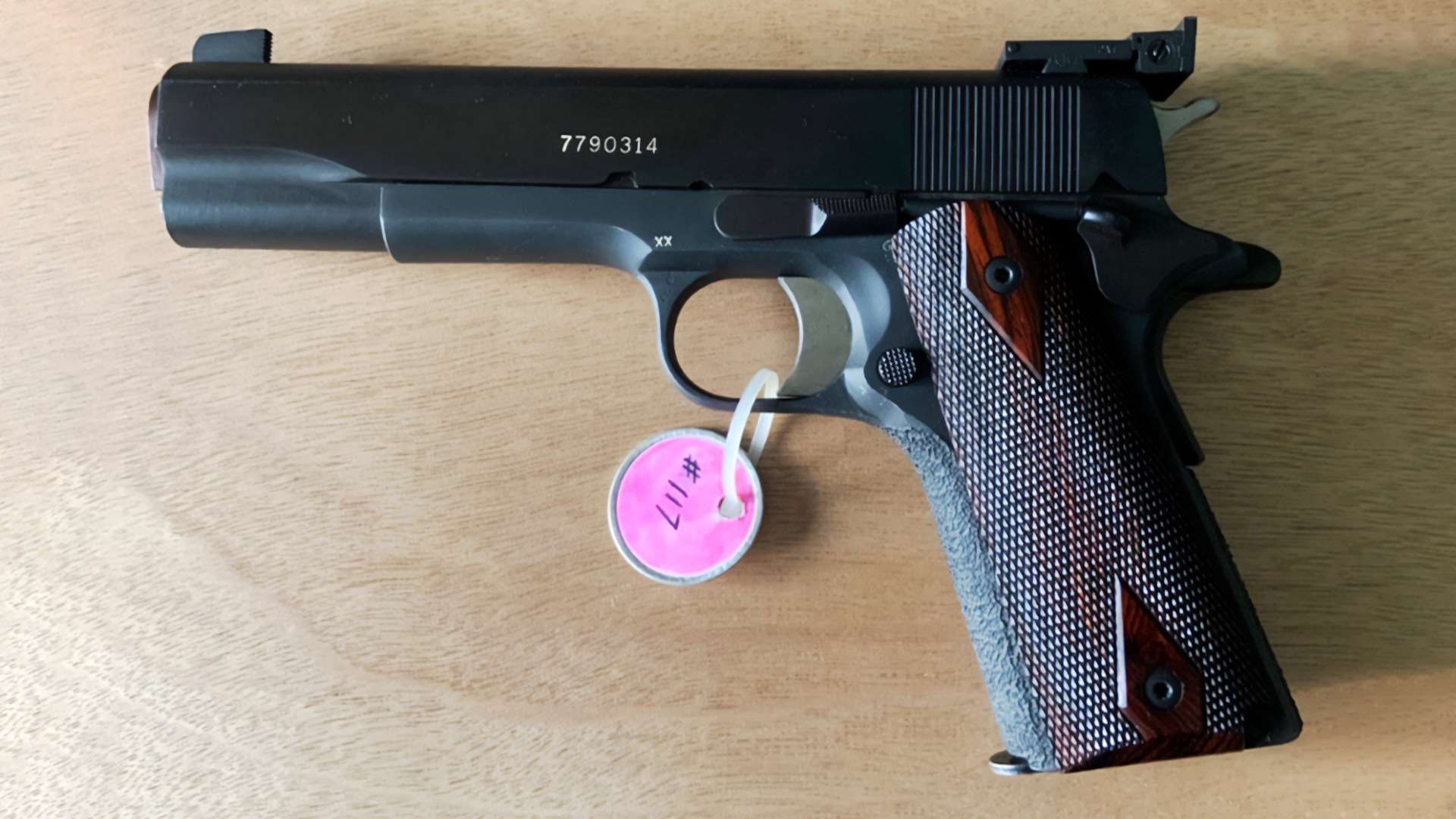
U.S. AIR FORCE SHOOTING TEAM HISTORY
Kimpo Air Force Base in South Korea served as a major evacuation site for Seoul stationed diplomats in 1950 when the Korean conflict began. It was overrun by communists on September 15, 1950, but was reoccupied two days later. It fell again on January 4, 1951, but retaken a month later for the final time.
While viewing the devastation of the original September invasion, Gen. Curtis LeMay was appalled as he surveyed all the dead airmen who had perished defending their base. They died hopelessly clutching their .30-cal. M-2 Carbines while futilely trying to reload them with M-1911 .45 Auto magazines.
At that moment, he vowed to train all airmen to a level of proficiency with their issued firearms so that a travesty like that could never happen again.
Once he had been appointed Vice Chief of Staff of the U.S. Air Force, LeMay was finally in a position to fulfill his vow of marksmanship training for all Air Force members. In 1959, he appointed Col. Thomas Kelly to establish a marksmanship school for the purpose of developing master gunsmiths and marksmanship instructors who would focus on training air crews and security forces.
The school was also commissioned to develop and field national and world-class competitive teams in smallbore and high power rifle, trap and skeet shotgun, national and international pistol and running boar tournaments. The school’s training program for small arms instructors was 12 weeks in duration. That marked the origin of the U.S. Air Force “Red Hat” career field.
The gunsmith shop not only built and maintained service firearms, but also evolved to a level of producing precision firearms fit for world-class competition. The custom pistol section of the shop was headed by master gunsmith Bob Day, who built match-grade .45 “Hardball guns” for the team. Only guns that met his high standard of being capable of 50-yard groups less than two inches were acceptable for competition. Those guns were stamped “AFPG,” which stood for Air Force Premium Grade. There was even a section in the shop devoted to testing and developing new systems.
From 1958 through 1969, the program produced legendary teams that far surpassed Gen. LeMay’s expectations. Once selected for team membership, marksmanship became that member’s career field of assignment. All 15 members of that original, legendary team were Distinguished Pistol shots. More than half were 2650 shooters.
Besides winning individual and team championships at the Interservice and National Matches, the team set a few records at those events that have continued to stand decades later. They also brought home international medals from the Olympic and Pan-American Games.
Unfortunately, the team was discontinued after drastic program defunding in 1969 following Gen.LeMay’s retirement. Articles by Charles Petty and T/Sgt. Arnold Vitarbo (USAF, ret.) provide a more comprehensive history of the pistol team from its 1959 origins through its resurrection as a modestly funded MWR activity years later.
After the 1969 budget cuts, a new process was established to extend the existence of an Air Force pistol team a bit longer. Each year, the team consisted of competitors who began their marksmanship journey by achieving membership on their base pistol teams, which usually competed locally. The next step was selection for a position on an Air Command Team following base team competitions at annual Air Command Matches.
Each spring, members of the Air Command Teams reported to the annual All-Air Force Matches at Lackland Air Force Base, where an Air Force National Pistol Team was assembled for the purpose of competing at the upcoming Interservice and National Matches. The primary responsibility of the final team members was not marksmanship, but rather their assigned military career field.
Training was accomplished during off-duty time. They were expected to furnish their own gear. However, the Air Force did provide gunsmith services and travel reimbursement to key national and international events. Unfortunately, all funding was discontinued in 1973. A few unsupported former team members did continue to compete as individuals over the next few years.
One such shooter was Steve Richards, who served as a lieutenant on the original Air Force National Team in the 1960s. He continued to compete on his own for two decades following the severe 1969 defunding of the program. By the 1980s, Col. Richards had become a Pentagon officer. He and a few other marksmanship supporters established that some Olympic events were shooting sports, and thereby qualified for funds allocated to train Olympic athletes under Public Law 84-11.
Consequently, the Air Force Sports and MWR office at Randolph Air Force Base began to set aside sufficient non-appropriated funds to resurrect a team. Shooters had to provide their own guns, ammunition and equipment. They had to train during their off-duty time. However, travel and per diem funds were available for major national and international competitions. A team member could only attend such events with his or her commander’s permission.
Their primary Air Force responsibility was to their assigned career field. This new program was designed to identify airmen who had developed to a competitive level on their own. Team try-outs were set up to occur each year at Lackland AFB. Most candidates at those trials had been well trained instructors or members of the security police.
That trip from the Florida panhandle to Cape Cod ended up taking three days. A Greyhound bus would have been faster. I have no complaints though—we arrived home safely. Further, that adventure was a preview of the great times to come.
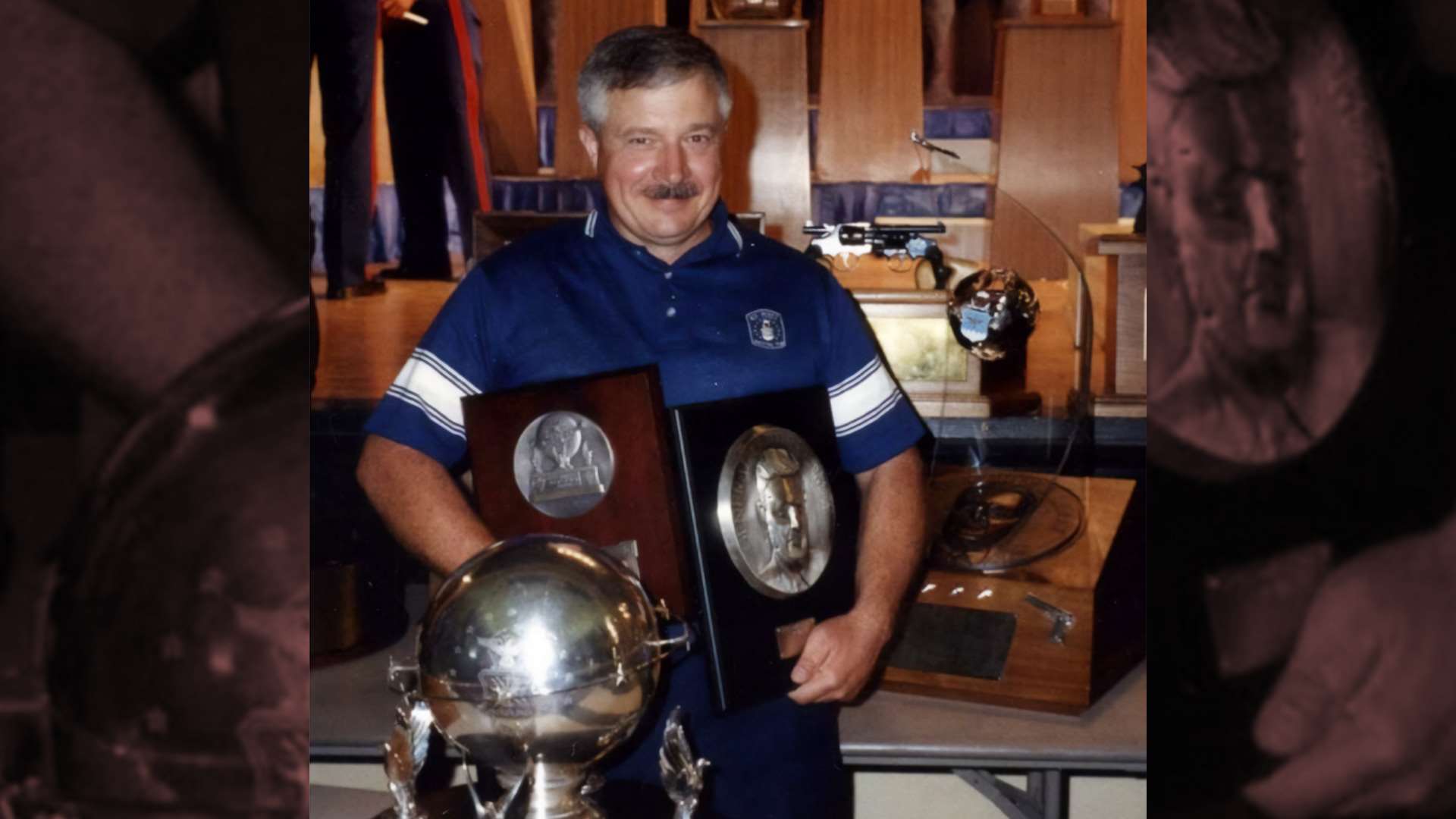
In the next installment, Doc Engelmeier will share more stories about his start in pistol competition, a daring flight and other adventures.
Learn more about the CMP at thecmp.org.













